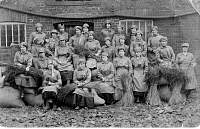The Flax Ladies

Glemsford Flax Factory Ladies
c. 1916
I'm fascinated by the group photo of the Glemsford Flax Factory staff. (the full detailed photograph is on the site). These ladies, with their striking features, gaze at the camera with a sullen dignity; bringing to mind Alexander Solzhenitsyn's wonderful phrase..
"The ferocious desire to appear happy at all times humiliates and undermines humanity. ...the inertia of accumulated suffering had freed us of that joyful air. In the face of the camera, our faces remain the way they are in real life -downcast."
The photograph was, we think, taken during the first world war, when Flax production was subsidised by the government. As always with group photographs, I ache to discover who they all were. We've identified a few; Miss Grimwood, Vin Prentice, M Shinn, R Shinn in the back row, and Mrs Clarke, Mrs Sparham and Mary Rampling in the front row.
The photograph hung in the doctor's surgery for a while, though I can think of cheerier scenes to choose.
The whole subject of the Flax industry is fascinating. It sustained Glemsford through a period of industrial and agricultural decline; there are still people around who worked in the Flax factories and have fascinating memories. It is the perfect subject of study for a local historian.


0 Comments:
Post a Comment
<< Home